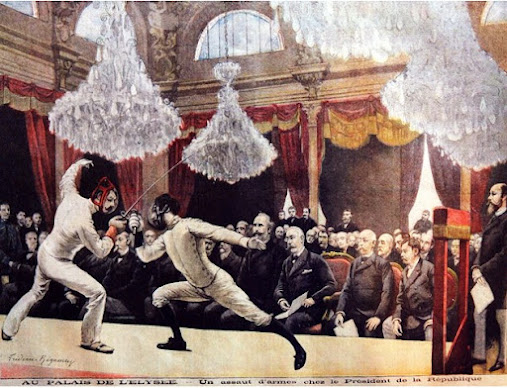Behind the Story: Puss Das Boot and the real fantastic stories of World War 2
 |
| Puss in Boots by Gustave Dore |
Animal Genetics
In the story, Puss is a genetically altered cat that speaks and aids a World War 2 French sailor named Guy.
Basis
for this idea comes from a German zoologist and researcher named Ludwig “Lutz” Heck who experimented
with genetics by cross breeding animals to reconstruct extinct breeds (His character is
portrayed in the book and the movie “The Zookeeper’s Wife” when Heck is named
director of the Warsaw Zoo in Poland).
 |
| Ludwig "Lutz" Heck |
Heck’s projects included cross breeding animals to revive extinct breeds. This was part of the Nazi ideology trying to return to the purity of a mythic past. Heck was fascinated with animals associated with the past, including an animal called the auroch, large cattle that stood nearly 6 feet tall and went extinct in the 17th century. Using a method called back-breeding, he would collect existing cattle species for the correct features, breeding them until they approximated the ancient animal. Heck wanted to create a symbol of German strength and courage, inspired by the hunter Siegfried from the epic German poem Song of the Nibelungs.
 |
| Heck Cattle, his attempt to back breed the extinct auroch |
In 1932, Lutz Heck became director
of the Berlin Zoological Garden, partly due to the influence of Hermann Goering.
Goering was President of the German Reichstagg, and in 1934 became the head of
the Reich’s forestry ministry (Reichsforstmeister) and chief huntsman of the
Reich (Reichsjägermeister). It was not difficult for Heck to win over the
Prussian Prime Minister, who was an avid hunter and attracted to the prospect
of establishing a large nature preserve where he could hunt mythic animals in a
return to a heroic Teutonic past. Lutz’s creations helped to populate the
preserve.
 |
| The Berlin Zoological Garden famous elephant entrance. |
The Berlin Zoological Garden flourished while the Nazis were in power, catering to the National Socialist Party members and their propaganda by excluding Jewish people and “Aryanizing” the zoo. Much of the zoo was destroyed during the Battle of Berlin, and after the war Heck escaped with his wife to Bavaria to avoid Soviet persecution. He died in 1984.
A Secret Allied Base
In the story, Puss leads the German captain to an Allied secret underground base called the Carabas Defense. In 1941 the British did plan a secret underground base, hidden under the rocky landscape of Gibraltar.
During WW2
Gibraltar was an overseas military base for the British. The strategic location
at the narrow pass to the Atlantic Ocean provided Allies with a Naval and Air
Base near the Mediterranean and made it an attractive target for the Axis
powers.
 |
| The rock of Gibraltar with peaks over 400 meters above sea level |
Fearing
that the Germans planned to capture it, Rear Admiral John Henry Godfrey, the Director of the Naval Intelligence Division of the Admiralty, devised Operation Tracer in 1941. Operation Tracer would
establish an observation post at Gibraltar that could continue secret
operations if the Axis powers captured it. The secret base, also referred to as
The Stay-Behind-Cave, could continue to observe movements of enemy vessels and
report back to the Allies.
An underground tunnel system was
constructed within the monolithic Rock of Gibraltar, expanding a tunnel system
which dated back to the 18th century. Construction was completed in
1942. The plan was to seal up half a dozen men in the bunker, providing them
with food and water, to covertly observe German operations in the area. While the plan was to keep them there for a year, they had
provisions for a stay of seven years. Rooms included living quarters,
observation areas, water supply, toilets, a radio room and even an area to bury
any members that might die while there.
 |
| Excavated room from the Stay Behind cave. |
Before
it was set into operation, the plan was aborted and the complex sealed up. The
team was disbanded and sworn to secrecy about the project. Rumors about the
complex existed until 1997 when the hidden chambers were discovered by a caving
group.
The Super Submarine
In “Puss Das Boot” the Wassermaus is an advanced German submarine that runs completely silent, armed with unerring robot torpedoes, an automatic pilot and was able to withstand vast depths as it traveled underwater for extended periods of time.
 |
| World War 2 kreigsmarine |
Submarine
warfare played a major role in World War 2. Allies and Axis powers raced to
develop undersea craft that could travel stealthily and attack with surprise
against the battle cruisers. The Nazi’s super-submarine was developed too late
to be any use during the war, but it was nonetheless an impressive machine for
its time.
.png) |
| Type XXI u-boat |
German
U-boats (undersea boats – submarines) were initially successful in its use of
submarine warfare to lay siege to Britain. But revised convoy tactics, radar
and patrol planes made ineffective Germany’s Type VII submarine fleet. The Type
VII submarines were slow and their electric engines were incapable of remaining
underwater for very long, making them vulnerable to the faster British warships
who could either detect them or outrun them.
It
was time for Germany’s engineers to come up with something better. The Type XXI
submarine ‘Elektroboote’ boasted 6 torpedo tubes and an improved electric
engine that allowed the craft to remain submerged and travel faster at about 18
knots (vs the Type VII traveling at 8 knots). It was equipped with radar and
sonar devices to help detect and hide from enemy ships. It was even supposed to
be fitted with a rocket that could fire upwards from the boat.
 |
| Snorkel on type XXI u-boat |
Also impressive was her snorkel, a sophisticated breathing tube that enabled the sub to run her diesel engines while submerged, charging batteries and making it capable of remaining submerged for prolonged periods and avoiding detection by radar or human lookouts. The hydraulic torpedo automatic loading mechanism quickened loading and reloading time, and the SU-Apparat (known as the Nibelung, Nazi’s had a fascination with the old poem), helped to track and determine the range of a victim without rising to periscope depth. It could accurately launch torpedoes at a depth of 50 meters. Her thickened hull allowed it to dive beneath most Allied depth charges. She even had an automatic pilot to keep depth at high speeds.
Seemingly
ideal and more powerful, the Type XXI ran in to problems typical of
experimental inventions. It didn’t work very well. By the time the hydraulic
torpedo loading tubes and problematic engine problems were resolved, Germany’s
strategy had shifted away from undersea warfare. Even if fully functional,
Germany still needed a fleet of such submarines to have an effect against
Allied shipping and warships. With only a few such submarines operational, they
could do little more than harass the enemy without doing real damage. 
The Type XXI submarine came too late in the war for Germany. Only one managed to get out of the docks, it’s initial voyage taking place on the same day Germany surrendered. It approached a British cruiser, but by that time had received word of the ceasefire. After surrendering at an Allied port, the U-2511 commander proudly pointed out that he had gotten within 600 meters of the British Cruiser HMS Suffolk and its escort of destroyers completely undetected.
Find the short story "Puss Das Boot" in the anthology "Fairy Tales Punk'd" at Amazon, Barnes & Noble and your local bookstore







Comments
Post a Comment